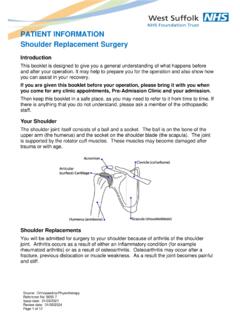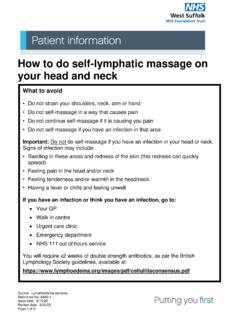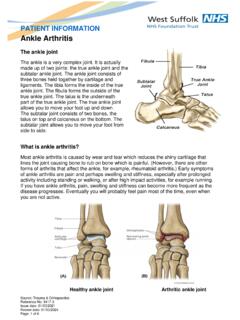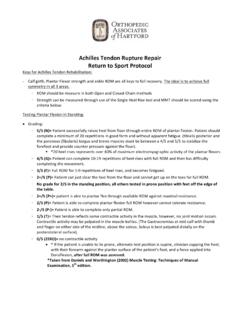Transcription of PATIENT INFORMATION Tibialis Posterior Tendon …
1 PATIENT INFORMATION . Tibialis Posterior Tendon dysfunction , Tibialis Posterior Insufficiency, or Adult Acquired Flatfoot Deformity Tibialis Posterior muscle The Tibialis Posterior is a muscle in the lower leg. The Tendon from this muscle runs behind the inside bone on the ankle (called the medial malleolus), across the instep and attaches to the bottom of the foot. The Tibialis Posterior is important as it helps to hold the arch of the foot up and stop the foot rolling over. Sometimes the Tendon becomes stretched and inflamed. This condition can be called Tibialis Posterior Tendon dysfunction , Tibialis Posterior Insufficiency or Acquired Adult Flat Foot. Source: Trauma & Orthopaedics Reference No: 6112-1. Issue date: 01/03/2021. Review date: 01/03/2024. Page: 1 of 9. Common causes Flat footedness: Most people who develop the condition already have flat feet. With overuse or continuous weight bearing, a change occurs where the arch begins to flatten more than before, with pain and swelling developing on the inside of the ankle.
2 Inadequate support from footwear may occasionally be a contributing factor. Trauma or injury: Occasionally this condition may be due to fracture, sprain or direct blow to the Tendon . Age: The risk of developing Posterior Tibial Tendon dysfunction increases with age and research has suggested that middle aged women are more commonly affected. Other possible contributing factors: Being overweight and inflammatory arthritis. Classification Tibialis Posterior Tendon dysfunction is a condition of increasing symptoms and deformity. It is however loosely classified into four stages as described below. Stage one: Tendon is stretched Medial ankle pain (instep), especially when walking Swelling along the Tendon Able to stand on tiptoe on one leg Usually treated with insoles and physiotherapy Stage two: Tendon is partially torn More severe pain and swelling Increased flattening of the foot Unable to stand on tiptoe on one leg Treated as above, Tendon reconstruction if necessary Stage three: Heel is fixed'.
3 Treated with the use of insoles (orthoses). A fusion of the hind foot may be necessary Stage four: Accompanying ankle deformity Surgery to the ankle may also be necessary Common symptoms Pain: Pain and/or swelling behind the inside of your ankle and along your instep. You may be tender behind the inner ankle (where the Posterior tibial Tendon courses), and occasionally get burning, shooting, tingling or stabbing pain as a result of inflammation of the nerve inside the tarsal tunnel. Difficulty walking: The inability to walk long distances and a generalised ache while walking even short distances. This may probably become more pronounced at the end of each day. Change in foot shape: Sometimes your Tendon stretches out, this is due to weakening of the Tendon and ligaments. When this occurs, the arch in your foot flattens and a flatfoot deformity occurs, presenting a change in foot shape. Inability to stand on tip-toe: A way of diagnosing Posterior Tibial Tendon dysfunction is difficulty or inability to heel rise' (stand on your toes on one foot).
4 You may also experience pain upon attempting to perform a heel rise. How it progresses Ageing leads to decreased strength of muscles, tendons and ligaments. If a person has flat feet, a greater weight is placed on their Tibialis Posterior Tendon . Over time this can cause stretching, inflammation and degeneration of the Tendon , which may result in the Tendon tearing. This process has a knock on effect to the arch of the foot, which may appear collapsed and the position of the bones of the foot and ankle may alter. Reasons for a Tibialis Posterior Tendon reconstruction A Tibialis Posterior Tendon reconstruction is usually performed for stage two symptoms, when the Tendon is partially torn, there is pain and swelling, the foot is becoming flatter, it is not possible to go up on tiptoes on the foot and function is becoming limited. Expected outcome Improved function/mobility/muscle strength Improved pain relief and less need to take painkillers Improved arch height and alignment, though deformity is not guaranteed to be fully corrected Stop the progression of the deformity however the risk of recurrence in the first few years is relatively high Returning to low impact sports may be possible but strenuous sport is unlikely Full recovery may take up to twelve months.
5 Treatment Adult acquired flatfoot is best treated early. Accurate assessment by your doctor will determine which treatment is suitable for you. Non-surgical Reduce your level of activity and follow the RICE regime: R Rest as often as you are able. Refrain from activity that will worsen your condition, such as sports and walking. I Ice, apply to the affected area; ensure you protect the area from frostbite by applying a towel over the foot before using the ice pack. C Compression, a Tubigrip or elasticated support bandage may be applied to relieve symptoms and ease pain and discomfort. E Elevate the affected foot to reduce painful swelling. Pain relief: You will be prescribed pain relief in the form of non-steroidal anti- inflammatory medications (if you do not suffer with allergies or are asthmatic). Immobilisation of your affected foot: This will involve you having a below the knee cast for four to eight weeks. In certain circumstances it is possible for you to have a removable boot instead of a cast.
6 A member of the foot and ankle team will advise as to whether this option is suitable for you. Footwear is important: It is advisable to wear flat sturdy lace-up shoes, for example, trainers or boots. This will not only support your foot, but will also accommodate orthoses (shoe inserts). Orthoses: Insoles, functional orthoses, ankle supports, braces, ankle foot orthoses (AFOs). are usually custom-made to increase the functional stability of the foot and improve the mechanical properties of the Tendon as well as reducing the actual degree of strain on the Tendon . This reduces pain and inflammation. Physiotherapy: Exercises and physiotherapy are often used to increase mobility, strengthen the Tendon itself, stretch your Achilles Tendon as well as reduce pain. Once the Tendon has been stretched (stage one), immobilisation in a cast may help the symptoms to subside and prevent progression of the deformity in a small percentage of patients. Long-term use of shoe orthoses (in soles) may help stop progression of the deformity and reduce pain without surgery.
7 Non-surgical treatment is unlikely to prevent progression to stage three and four but may be chosen by some patients who either are unsuitable for surgery or prefer not to have surgery. Surgical technique(s). Surgery may be offered and performed when non-surgical measures have failed. Surgery is commonly performed under general anaesthetic and in combination with a nerve block which helps reduce post-operative pain. Regional anaesthetics are also possible and will be discussed with you by your anaesthetist. The goal of surgery is to eliminate pain, stop progression of the deformity and improve a PATIENT 's mobility. More than one technique may be used and surgery tends to include one or more of the following: The Tendon is reconstructed or replaced using another Tendon in the foot or ankle. The name of the technique depends on the Tendon used: o Flexor digitorum longus (FDL) transfer o Flexor hallucis longus (FHL) transfer Tibialis anterior transfer (Cobb procedure).
8 Calcaneal osteotomy the heel bone may be shifted to bring your heel back under your leg and the position fixed with a screw Lengthening of the Achilles Tendon if it is particularly tight Repair one of the ligaments under your foot Hind foot fusion surgery (see separate leaflet for further INFORMATION ). Calcaneal osteotomy If you smoke, your surgeon may refuse to operate unless you can refrain from smoking before and during the healing phase of your procedure. Research has proven that smoking delays bone healing significantly. Before the operation (pre-operatively). You will see a pre-admission nurse to check you are medically well enough for surgery. It is important to mention any medicines that you are taking, either prescribed or non-prescribed, including over the counter medications eg herbal remedies or aspirin, warfarin, hormone replacement therapy (HRT), the contraceptive pill or medication for high blood pressure. Prior to admission for your surgery there are a number of issues that need to be considered, for example, can someone help you carry out basic everyday tasks such as preparing food and food shopping?
9 If you have stairs, how will you get up and down them? Do you have sturdy hand rails? If your toilet is downstairs, would it be easier to have your bed downstairs until you have recovered and are able to negotiate the stairs safely? The pre-admission nurse will discuss these with you and if they have any concerns about your coping at home after your operation, they may refer you to a physiotherapist and/or an occupational therapist. The therapist will telephone you to discuss your needs and it may be necessary to attend for a more in-depth assessment. This will ensure that we plan for your discharge home safely and shorten your stay in hospital. What to bring with you Please ensure that you have a flat sturdy shoe to wear on the non-operated foot following surgery. If you use a walking stick or crutches, please ensure you bring these with you. After your operation You will usually stay in hospital for approximately one to two days after your operation. A.
10 Physiotherapist will see you on the ward and teach you how to walk using a walking aid. If you have to use stairs at home you will be taught the safest way to do this. Treatment is individual for each PATIENT . However, it is normal, following a Tendon transfer and calcaneal osteotomy, for you to have a plaster cast in place following your operation. Your foot may be placed in an inverted position (facing inwards). You will not be allowed to bear weight upon the operated leg initially. Outpatient review You will be given an appointment to attend the Outpatients' Department two weeks following your procedure. The sutures will be removed and your wound site will be inspected. A new plaster will then be reapplied. Your plaster cast may be changed every two weeks until your foot is in a neutral (natural). position. You will be non-weight bearing, this means NO weight is to be put through the affected limb, until your foot is in a neutral position. When the foot has reached a neutral position you may put your full weight through the operated limb while walking.











